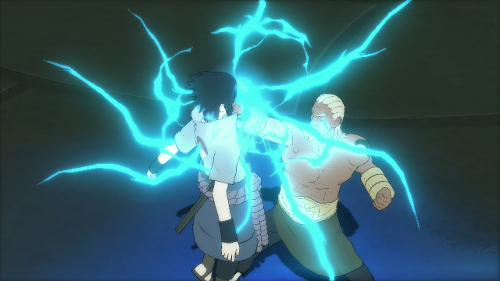If you’ll recall, last year I reviewed Naruto Ultimate Ninja Storm 2 and gave it a great score, praising the gameplay as well as the way that the game covered the details of the story. This year, we have the sequel to the game, titled Naruto Shippuden: Ultimate Ninja Storm Generations. I fought through hordes of shinobi to bring you this review, so I hope you appreciate the blood I shed for you, dear readers.
Last year’s Ultimate Ninja Storm 2 was a great title, and it brought me so brilliantly up to speed on the Naruto story that I didn’t feel like I needed to read the manga or watch the anime. For me, this was one of the greatest assets of the title, gameplay aside. In fact, I’ll even wait around while you go off and read that last review if you feel you need a reminder. Back? Good.
Naruto Shippuden: Ultimate Ninja Storm Generations is the latest game in the Ultimate Ninja series, and as before, the game is primarily a fighting game featuring the characters from Masashi Kishimoto’s famous manga and anime series. Like many “sequel-type” reviews, this one is going to be a rundown of what’s different.
One of the primary differences between Generations and the prior game is the removal of the RPG elements. Instead, Ultimate Ninja Storm Generations features a stripped-down story mode that allows you to play through 11 character stories, 10 if you count both the young and older Naruto as the same character. The story mode is essentially a string of battles separated by beads of non-interactive story, essentially reducing the game to little more than an anime-themed fighting game with bits of cutscene in between.
Playing through the other back stories, such as Zabuza’s, Minato’s, or Kakashi’s, gives you a lot of the motivation and character development that you saw in the manga and, to some extent, in the anime. However, if you were already familiar with the source material, there’d be very little here that would be new to you, especially since the cinematics are completely free of button presses. Still, it’s nice to get the reminders of the back stories of all these characters.
Whereas in the prior games you had access to the shops via the environments, this time around the shops are reduced to a series of menus, accessible from the game’s main menu. The shop, of course, is the only place to purchase items that you can use during battles, and like the previous game, you can also purchase cards. The cards this time form the basis of a pre-battle for your multiplayer battles. More on the multiplayer later. Like the previous game, you earn cash for every fight that you win, and the better you do (given a specific number of win conditions), the more money you earn. Trust me, it’s going to take a lot of money to buy all the things that are available!
The battles themselves have not changed significantly from the last game, and this is both a good and a bad thing, since the same problems that plagued the last game persist here. It’s like being bothered by last year’s mosquitoes. On the one hand, if you’re familiar with the button combos and fighting methods, it’s just as simple to get back to this game. On the other hand, there is still very little to distinguish one character from another when the time comes to actually polish each other’s faces with your knuckles. So even if you play with every single one of the 70-odd characters, you’ll never need to recall any out-of-the-ordinary button combos. Like before, what makes a difference to how you play is the allies that you choose to bring into battle with you; each ally can provide support in one of three different ways, and choosing your allies carefully is just as much a part of the strategy as the actual fighting. One of the biggest changes in the battle system is that the substitution technique (essentially a counter-attack manoeuvre) no longer consumes chakra; it now has its own bar dedicated to it, allowing a maximum of five substitutions in a row before needing to let it recharge.

A little variation in the gameplay would have been nice. I found this game an brilliant exercise in repeatability. One of the things I seriously miss about the previous game is just how cinematic it all was, with the quick time events in the middle of epic battles. It made the battles really come to life. Sadly, this sort of thing is missing from this game, although a number of the more powerful moves have noninteractive cinematics attached. Still, the fighting is still completely solid and easy to pick up. Button mashing will probably get you through the majority of the battles you’ll face, but you’ll need to strategy up a little towards the more difficult ones, and think about the approach. Split-second timing is less important to Generations than strategy; knowing when to block, when to attack, when to back off, and when to use your limited number of substitutions will get you further than timing your button presses just so.
The multiplayer is about the same as it was last round, with a few new modes thrown in for good measure. Offline battling allows you to go head to head with either a friend or against computer-controlled opponents. Why you’d go for the COM option instead of playing through the single-player campaign is beyond me, so that mode seems a little redundant. When you take the game online, you suddenly see a wider game opening, and it’s here that the game really starts to shine. Essentially, there are two online modes: non-ranked player matches and ranked matches. In player matches, there are several types of battle, including the standard one-on-one battles, endless battles, and tournaments. The matchmaking was not bad, although you’re probably better off choosing opponents than letting the matchmaker find you one.
One interesting aspect to the multiplayer is the card battle that happens before the actual fight. The in-game shop has several hundred cards and card titles available for purchase. Each card has an element and an effect attached to it, and before battle begins, the two opponents’ cards are compared. The winning card obtains the effects listed on the card, so choosing your card wisely can give you quite an advantage in battle. For those who like to study their opponents, the game also allows you to upload and download videos of matches, but you’ll need to spend in-game cash to be able to upload battles.
My bet is that Naruto fans are going to probably end up buying this game anyhow, no matter what I say here. Is it the kind of game that serves as a good introduction to the Naruto universe, though? My gut says no: there are too many intricacies and characters to make a newcomer care, and the story mode here serves as very little but a way to bridge a series of fights. Is it a great game to introduce to a newcomer to fighting games? Hell, yes. Point in case: I asked my non-gamer wife to pick up the second controller and go a few bouts with me. She was extremely reluctant, but by the end of of it, despite my experience with the game, she was thrashing me quite soundly, purely on the basis of button mashing.
The question that I’ve been asking myself throughout this review is “was this game actually necessary?” and my feeling is that it wasn’t. It doesn’t do much to improve upon the prior game. That being said, it’s still a damn solid game with very few flaws. The music is awesome, the voicework is top class, and the animation is so stunning that it’s hard to believe that you’re not watching the actual show. If you didn’t pick up the last game and you’re a fan of the Naruto series, you could definitely pick up worse fighting games than this one. But then, if you’re a fan of Naruto, you probably already have this game, don’t you?
Final Score: 8 spiky-haired, anime prawns out of 10
Detailed information:
Developer: CyberConnect2
Publisher: Namco Bandai
Distributor: Megarom
Release Date: 30 March 2012
Platform: PS3 (reviewed), Xbox360
Age Rating: 12
Website: http://www.uk.namcobandaigames.eu/product/naruto-shippuden-ultimate-ninja-storm-generations/playstation-3








1 reply on “We Review: Naruto Shippuden: Ultimate Ninja Storm Generations”
Thanks for the review of Naruto Shippuden: UNSG! :)